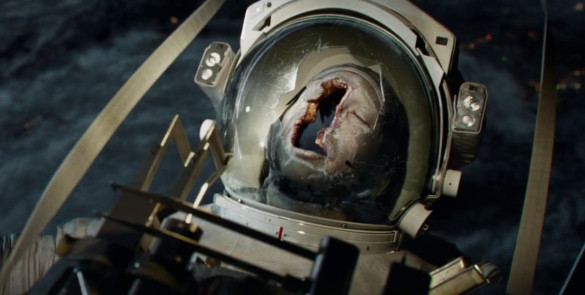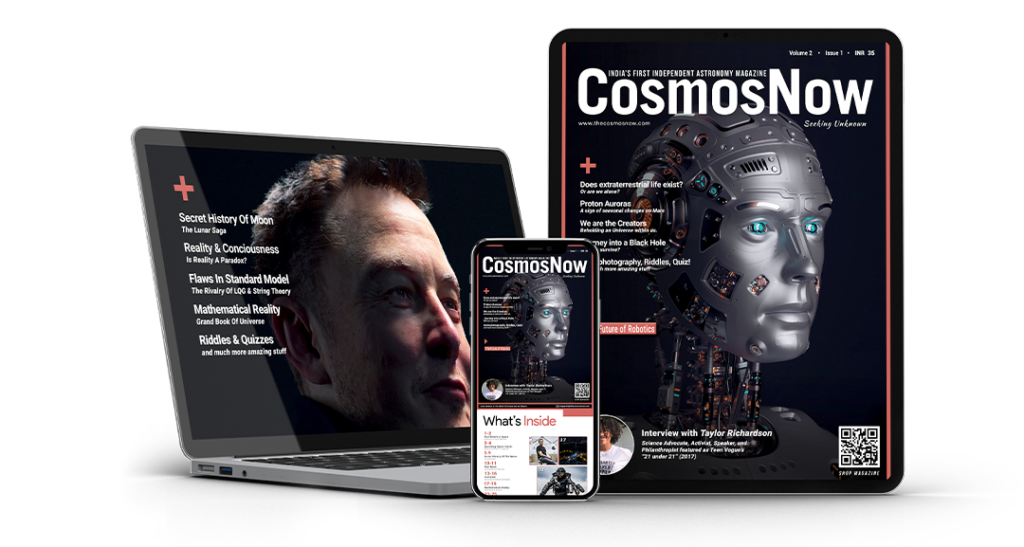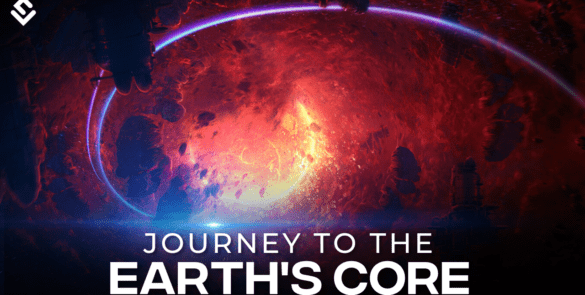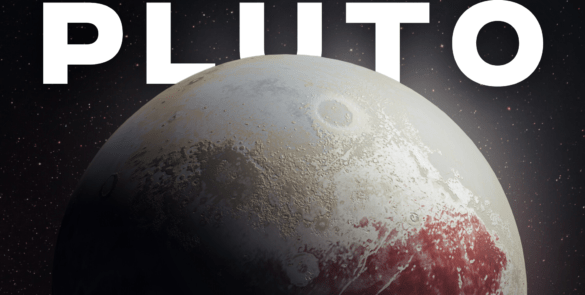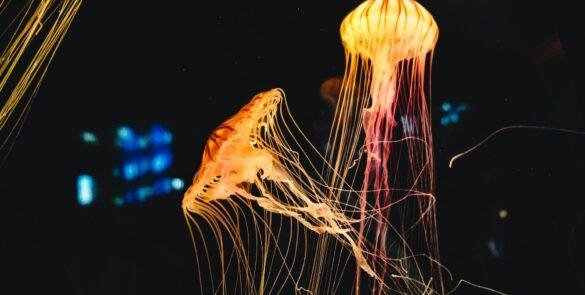5 Best Travel Spots in the Solar System To Visit
- Team WOS
- 10 Mins Read
WOS is supported by its audience. When you purchase through links on our site, we may earn an affiliate commission “from advertisers”, while you don’t need to pay in addition.
Let us take a trip to the TOP 5 magnificent travel spots in our solar system. Watch this video for a better experience.
The universe is filled with breathtaking views, shiny stars, glowing galaxies, pulsating magnetars, dark wandering planets, and whatnot. Scientists and curious people tried to see this outer envelope around the planet and tracked the movements of tiny shining dots. A major revolution came when telescopes were invented and we began to see the planets in their glory. People thought they had witnessed heaven.
Imagine the feeling when Huygens first saw the rings around Saturn. Who could have thought of a planet with rings revolving around it? The 17th century was the birth century of modern astronomy and one can imagine what amazing years they have been. Next, we reached space ourselves. There is a biblical myth of the Tower of Babel when people tried to ascend to heaven but God tried a sort of divide and rule that gave people on each level a different language and now they were unable to communicate and hence the plan failed.
But curious minds of the 20th century did it. We sent satellites and probes to our distant cousins and giant planets and witnessed heaven. Every planet, every moon has a different landscape and some unbelievable structures. Even though our Earth is not short of breathtaking tourist spots, let us take a trip to TOP 5 best travel spots in the solar system to visit.
1. Tranquility Base, Moon
This is one of the few places in our solar system where humanity has left its footprints and is known only because of human endeavor. This is the Apollo 11 landing site and known as Moon’s sea of Tranquility where Neil Armstrong and Buzz Aldrin set foot as the first humans on the surface of the Moon, on July 20, 1969. We landed in a different world.
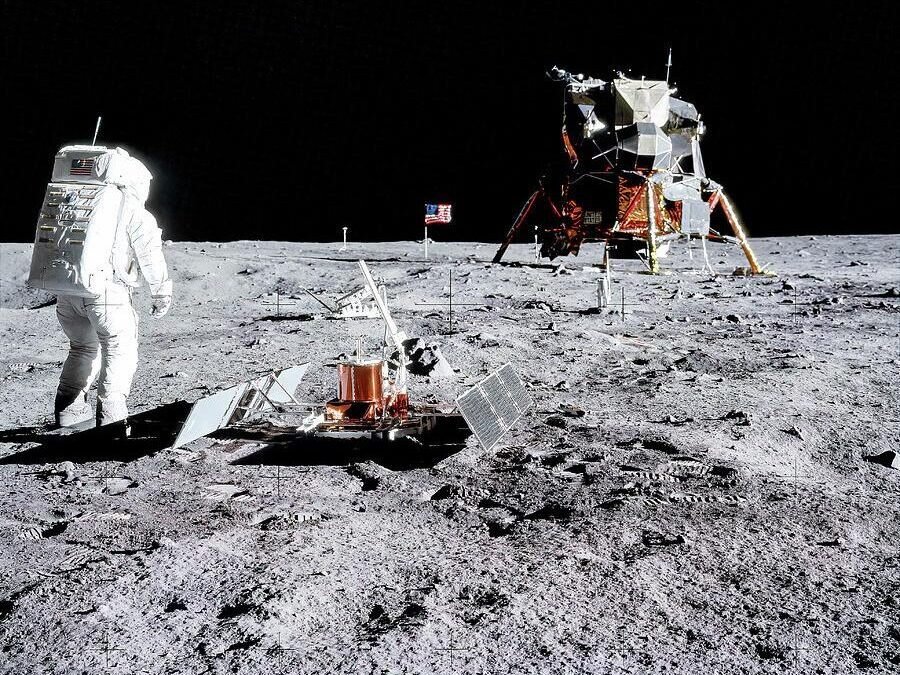
Astronaut Edwin “Buzz” Aldrin deploying two experiment packages during the Apollo 11 EVA. Image Credit: NASA
The lower part of the lunar module Eagle is still left there, with a standing flag of the United States. The Moon’s surface is filled with deep and large craters, thus a suitable place was needed to land safely. Planners in NASA searched and surveyed 30 suitable locations based on high-resolution photographs taken by the Lunar Orbiter spacecraft. Later 5 sites were shortlisted near the equator of the moon.
Site number 2 which was later named as Sea of Tranquility was ultimately chosen for the landing. The Lunar module landed safely but was 6 km away from the original proposed landing site. The surface at the landing site contains much-fragmented debris in the size range of 0.8 meters wide.
Armstrong came out of the spacecraft some 6 hours 39 minutes after the landing and 19 minutes later Buzz Aldrin followed Neil. They jointly spent nearly 2 hours and 31 minutes on the lunar surface photographing and collecting samples. They lifted off the surface on July 21 at 17:54 UTC. It was Neil and Buzz’s mention that got the landing site its name as the Tranquility base. It is nothing but the most important footprint of humanity.
2. Olympus Mons
If you think Mount Everest is a mighty one and the biggest physical structure anyone has ever seen, you are mistaken. The highest mountain peak in the solar system is not on Earth but on Mars. Olympus Mons is the largest volcano in the solar system. It rises to a magnificent height of 22 km above sea level. Mount Everest is only 8.8 km high.
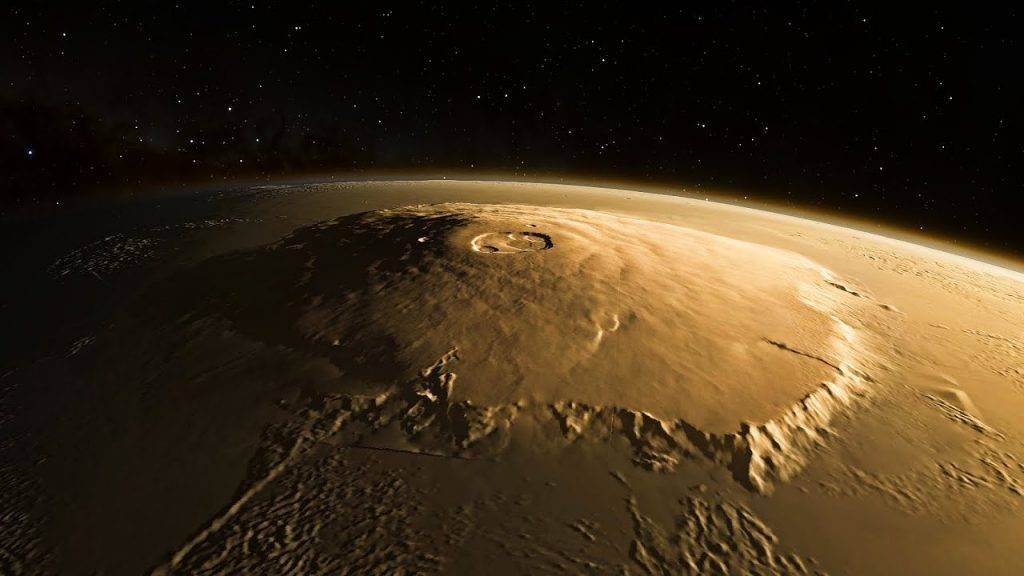
Olympus Mons is about two and a half times Mount Everest‘s height above sea level. It is the largest and highest mountain & volcano of the Solar System.
It is even higher than the depth of the Mariana Trench which is approximately 11km deep and is the deepest known point on Earth. The lower portion of the volcano is a cliff-like structure that rises nearly 10 km high and above it, the mountain rises with a very shallow slope which is nearly 85 km across. Overall the mountain range covers an area equal to the area of the state of Arizona.
Olympus Mons is a shield volcano. Unlike other volcanoes which spew molten lava, Olympus is created by slow-moving lava flowing down the sides of the mountain. This molten lava cools down and forms a new layer above it, thus raising its height. As a result, the slope of the mountain is extremely low.
If you climb above the cliff and look around the top of the mountain, you will experience not a high rising peak like Everest but a long stretching barren rocky, plateau-like structure with a gradually rising slope. It is still an active volcano and will continue to rise a bit. It took billions of years for the formation while some of its portions are only millions of years old. This magnum structure will surely be a worthy tourist destination if a future colony on Mars ever happens.
3. The Great Red Spot
This is one of the most famous places in the solar system and any space enthusiast must have seen or heard of this event, which is visible from the face of the largest planet in our solar system, Jupiter. It is not a particular place on Jupiter’s surface, and by the way, Jupiter does not have a solid surface like that of the terrestrial planets.
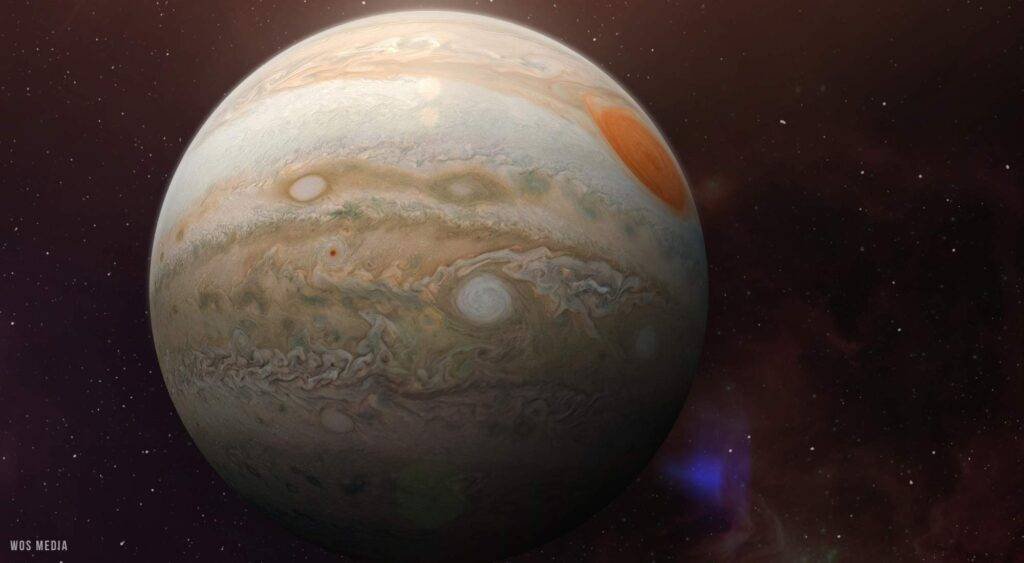
The Great Red Spot, is a long-lived enormous storm on Jupiter and the most significant feature of its visible cloud surface.
The Great Red Spot is a huge oval storm that is twice the size of the earth. It is the most common feature in the observation of Jupiter and has been in continuous observation since 1878. The storm is fierce with a wind speed of 400 km/hr, more than twice the speed of the strongest hurricane wind on Earth. It is happening in the upper main cloud layers of Jupiter, and scientists are unsure about how deep this storm extends into the interior layer.
The spot changes its color when it is covered by different layers of cloud but its predominant color is red, and astronomers generally predict that this is due to the presence of compounds of sulfur and phosphorus. The images are visually striking and vibrant. Jupiter has no solid land surface where such storms can make landfall and thus this great storm has been happening for such a long time and will continue for thousands of years in the future. It will be such a good event to watch while being aboard an orbiter around Jupiter if any human mission ever happens for Jupiter.
4. The Rings of Saturn
Galileo was the first person who, with the help of his telescope, saw the rings around Saturn but couldn’t make sense of it as his telescope was not able to resolve the distance so closely packed. It was later Christian Huygens who found that Saturn is surrounded by a network of rings. They have a diameter of 270,000 km, but they are thin, with a thickness of only 100 meters.
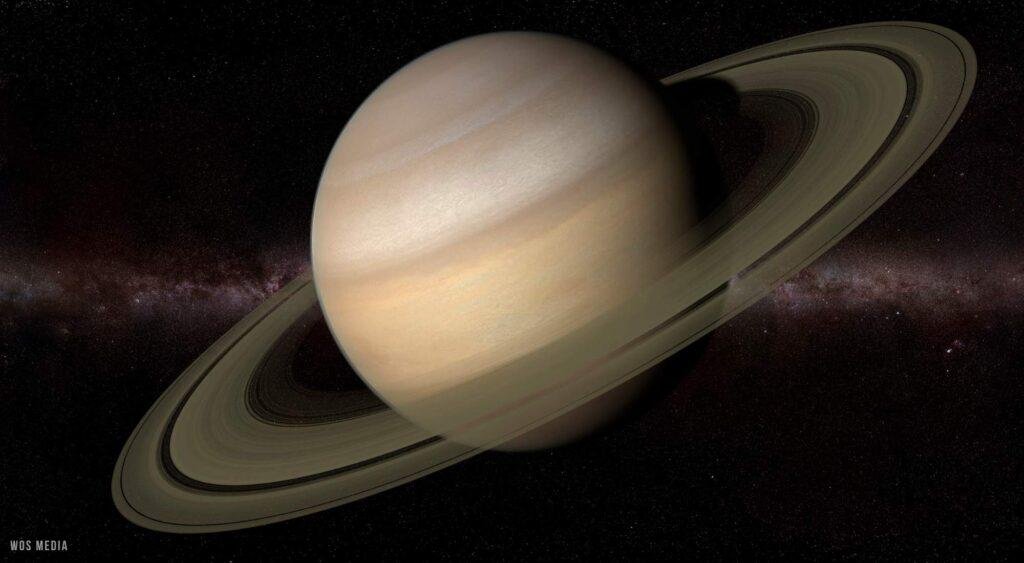
The rings of Saturn are the most extensive ring system of any planet in the Solar System.
The ring is made up of small to large rocks and dust particles. The tidal force keeps them in orbit and prevents them from forming an agglomeration. Scientists believe that either they are made up of pieces of moons of Saturn that were crushed under the huge gravity of Saturn or they were crushed due to collision with a passing comet. Each ring contains small pebbles while some are as large as mountains and each ring revolves at a different speed.
Rings are named alphabetically in the order they were discovered. The main rings are A, B, and C. Rings D, E, F, and G are fainter rings and they were discovered more recently. The data collected from Cassini suggest they are young and formed some 100 million years ago. Also, they are losing weight and density with passing time, this means they must have been far bigger than their present shape and size. Maybe we are just at the right time so that we can look at this beauty.
5. Korolev Crater on Mars
Another gem located on Mars is Korolev Crater, located in the northern lowlands of the red planet. This crater is 82 kilometers in diameter. The entire structure is always filled with ice, and this is what makes it a special place on a planet that is made largely up of oxidized iron. This ice-filled impact crater is located at 73° north latitude and 165° east longitude and contains about 2,200 cubic kilometers of water ice, which is equal to the volume of water present in the Great Bear Lake in Canada.
The crater was named after Sergei Korolev (1907–1966). He was a Soviet rocket engineer and designer during the Space Race in the 1950s and 1960s. The crater is surrounded by a rim that rises to a height of 2 kilometers and behind the rim, there are 1.8 kilometers of deep water ice that stretches up to 60 kilometers in diameter.
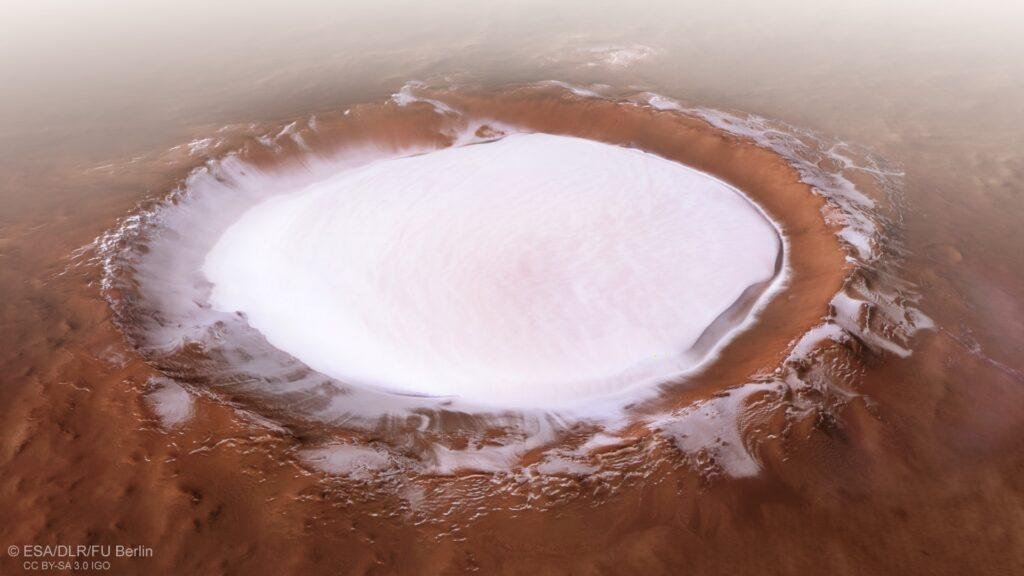
Korolev crater, an 82-kilometre-across feature found in the northern lowlands of Mars. Image Credit: ESA
There is an interesting physical process involved that keeps the ice sheet permanent. The thin air above the crater is colder than the air surrounding the crater. Since colder air is heavier than hot air, it always remains closer to the ice sheet and forms a protective layer around it keeping the ice sheet insulated and preventing it from melting. The rim around the ice cap plays an important role in this process which is known as Cold Trap. It looks like a frozen oasis in a red desert.
Not just these five but the solar system is filled with many such places that can teach as many things from physics to chemistry, and they are vibrant to look at and make us awe in praise of mother nature i.e. the universe.
What are your thoughts about these must-visit places in our solar system? Do you know more such spots? Let us know in the comments.
Share this article
Team WOS
Share this article
Robert C. JacobsonSpace has the ability to produce a triple bottom line, or ROIII: Return on Investment, Innovation, and Inspiration.
Latest posts
We have learned many partial truths and some remain with us even when we are studying higher courses. Let’s look up such partial truths that are very common...
How do the animals and birds view the world around them? Do they perceive everything just like a human? Let's understand the basic anatomy of the eyes of...
What will the conditions be for the human body in space? How much difference a human being would feel while being in space? Space is scary and lonely, and conditions are...
Here is a list of the best science books that'll take you deep into the ocean of science. Books fueled the mighty revolutions in human history and produced...
World's most renowned scientists think that the cosmos has quantum consciousness. First of all, what exactly is consciousness? Scientists are actively engaged experimental tests of these ideas. One approach is to study brain-impaired patients to see if their information...
Trending Articles
We have learned many partial truths and some remain with us even when we are studying higher courses. Let’s look up such partial truths that are very common...
We have explored only a few percent of Earth but what if we could somehow reach the center of the Earth? Today let’s go on a Journey To The Earth's Core. The underworld has been in the imagination for many centuries — be it a place of hell or the afterlife, or a place from which future heroes will...
What will the conditions be for the human body in space? How much difference a human being would feel while being in space? Space is scary and lonely, and conditions are...
You have heard of the ambitious dream of Elon Musk to colonize Mars in the coming decade. Well, many people ask what this fascination with Mars is? Why not...
Is Pluto a planet or not? The debate over its classification rages on, with some scientists advocating for a return to its original status. The controversy over Pluto's planetary status raises larger questions about how we define and categorize objects in space
The animal kingdom has evolved from unicellular organisms to gigantic dinosaurs and intelligent social animals, like us, Human beings! Throughout this evolutionary history, different species have left some characteristics or gained something new depending upon




